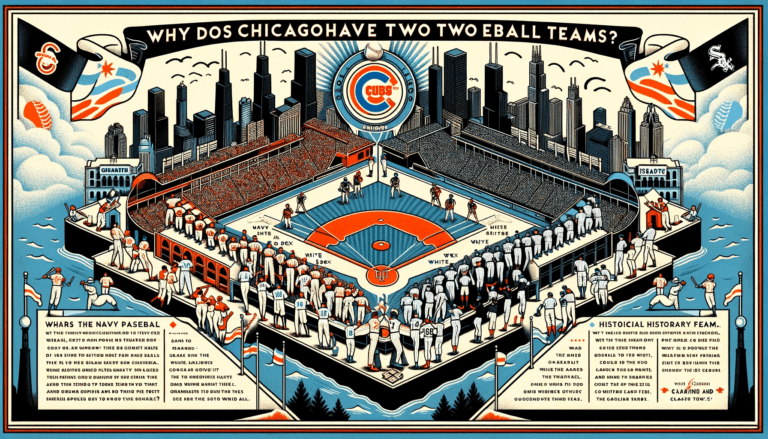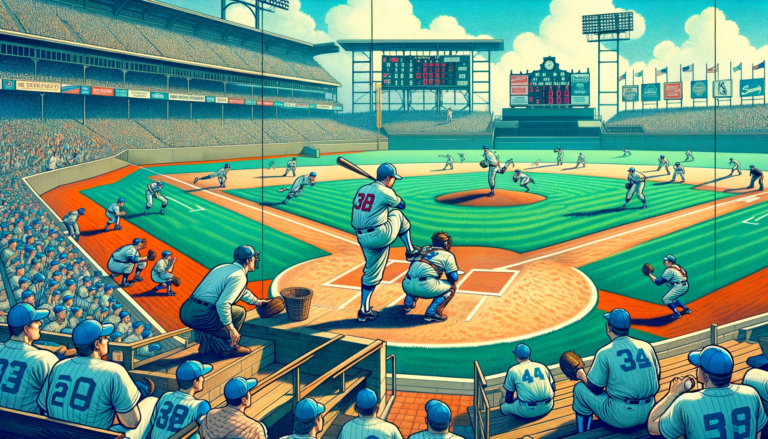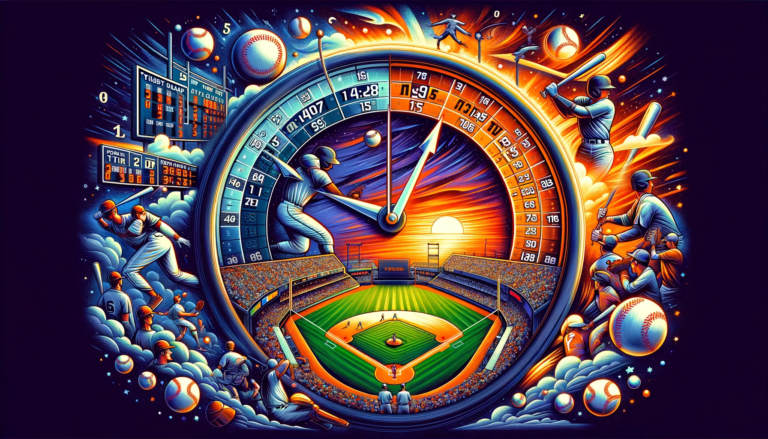How Many Acres in a Baseball Field?
The standard size of a professional baseball field is approximately 4.5 acres. This size includes the infield, outfield, and all the space where the game is played.
In this article, we’ll explore why baseball fields are this size, how they compare to other sports fields and other interesting facts about baseball field dimensions.
Key Takeaways
- A standard baseball field’s dimensions are carefully defined, with specific measurements for the infield diamond, outfield boundaries, and the pitcher’s mound.
- Baseball field sizes can vary between Major League, Minor League, and youth/amateur levels, as well as internationally, affecting how the game is played.
- Calculating the acreage of a baseball field requires understanding the unit of measurement and considering all parts of the field, including the outfield’s variable dimensions.
- The size of a baseball field influences game strategies, with larger fields affecting batting, pitching, and defensive tactics, and even offering potential home field advantages.
- The total acreage of a baseball facility includes not just the playing field but also support areas like dugouts and bullpens, as well as fan accommodations like parking and seating.
The Dimensions of a Standard Baseball Field

Infield Measurements: The Diamond’s Size
The heart of any baseball field is the infield, often referred to as the diamond due to its shape.
The distance from home plate to first base, and subsequently between each base, is a uniform 90 feet in professional baseball. This precise measurement ensures a level of consistency across games and venues.
Key distances within the infield also include the pitcher’s mound, which is centrally located 60 feet 6 inches from home plate.
This distance is critical as it influences the reaction time of batters and the effectiveness of pitchers.
The area within the bases, known as the infield, is typically covered with a layer of dirt, which affects the speed and bounce of the ball.
- Home plate to first base: 90 feet
- First base to second base: 90 feet
- Second base to third base: 90 feet
- Third base to home plate: 90 feet
- Pitcher’s mound to home plate: 60 feet 6 inches
Outfield Boundaries: From Fences to Home Plate
The outfield is the grassy area beyond the infield, and its boundaries are defined by the outfield fences.
The distance from home plate to the outfield wall can significantly influence the nature of the game, with shorter distances favoring hitters and longer ones benefiting pitchers.
- The minimum distance from home plate to the left and right field foul poles is typically 325 feet.
- Center field distances are greater, often exceeding 400 feet.
These measurements, however, are not uniform and can vary widely from one ballpark to another, reflecting the unique character and strategy of each venue.
The outfield dimensions are a critical aspect of a baseball field’s overall acreage and play a pivotal role in the game’s dynamics.
Pitcher’s Mound and Baselines: Key Distances
The pitcher’s mound serves as the epicenter of the baseball field’s geometry. It is precisely 60 feet and 6 inches from home plate, a distance that has remained unchanged since the late 19th century.
This key measurement ensures a balanced duel between pitcher and batter, making it one of the most critical aspects of the field’s design.
In addition to the pitcher’s mound, the baselines are fundamental to the field’s layout. The distance from home plate to first base and from third base to home plate is exactly 90 feet in professional baseball.
These distances are shorter in youth leagues to accommodate the players’ age and skill levels.
The following list outlines the standard distances for a professional baseball field:
- First base to second base: 90 feet
- Second base to third base: 90 feet
- Third base to home plate: 90 feet
- Home plate to the backstop: 60 feet
These measurements create the infield’s square shape, known as the diamond, and are essential for ensuring fair play and maintaining the integrity of the game.
Read Also: How Many Innings in College Baseball
Variations in Baseball Field Sizes
Major League vs. Minor League: Contrasting Field Sizes
While Major League Baseball (MLB) fields are renowned for their grandeur and uniformity, Minor League Baseball (MiLB) fields can exhibit a greater variety of dimensions.
This is partly because MiLB serves as a developmental stage for players before they reach the MLB, and the fields reflect a range of facilities from different eras and locations.
- MLB fields typically adhere to strict regulations regarding field size, with outfield fences generally ranging from 325 to 400 feet from home plate.
- In contrast, MiLB fields may vary more significantly in size, with some having shorter fences that can influence the number of home runs hit during a game.
The disparities in field sizes between the two leagues can affect player development, as minor leaguers may need to adjust to larger field dimensions upon advancing to the major leagues.
This transition is an essential aspect of preparing players for the challenges of MLB play.
Youth and Amateur Baseball: Adjusting for Age and Skill
In youth and amateur baseball leagues, the dimensions of the field are scaled down to accommodate the developmental stages of younger players.
The size of the field is crucial for ensuring that the game is both challenging and safe for the age group playing.
For instance, in the JYBSA League, the Minor League division for ages 9-10 adapts the field to fit their growing skills.
Field sizes are typically adjusted by reducing the distance between bases and the distance from the pitcher’s mound to home plate.
This allows younger players to experience success in hitting and fielding, which is essential for their continued interest and improvement in the sport.
The following are common adjustments made for youth baseball fields:
- Bases are set closer together, often ranging from 50 to 70 feet apart.
- The pitcher’s mound is closer to home plate, usually around 35 to 50 feet.
- Outfield fences are brought in to create a more reachable boundary for young hitters.
These modifications help bridge the gap between the capabilities of young players and the demands of the game.
They create an environment where young athletes can build and refine their fundamental skills. At the same time, they start to understand game strategy and teamwork.
International Fields: How They Differ from U.S. Standards
Baseball fields around the world can vary significantly when compared to the standard dimensions found in U.S. Major League Baseball.
International regulations often allow for greater flexibility in field size, which can lead to a diverse range of playing environments.
- In Japan, for example, the fields tend to be slightly smaller, which can affect the dynamics of the game, particularly in terms of home runs and outfield play.
- Latin American countries often feature larger outfields, which changes the way outfielders position themselves and can influence the number of extra-base hits.
These variations are not only influenced by the regulatory bodies but also by the cultural preferences and historical development of the sport in different countries.
The diversity in field sizes reflects the global nature of baseball, with each region imprinting its own style on the way the game is played.
Calculating the Acreage of a Baseball Field

Understanding Acre as a Unit of Measurement
An acre is a unit of area commonly used in the United States to measure large plots of land. One acre is equivalent to 43,560 square feet, a size that can be difficult to visualize without context.
To put it in perspective, consider the following comparisons:
- An acre is about the size of a football field without the end zones.
- It’s roughly the size of 16 tennis courts laid side by side.
- You could fit approximately 9 standard-sized home lots of 50 feet by 100 feet into an acre.
Understanding the size of an acre is crucial when discussing the acreage of a baseball field, as it provides a clear reference for the scale of the area involved.
This knowledge is especially important when we delve into the specifics of measuring a baseball field’s total acreage.
Step-By-Step Guide to Measuring a Baseball Field
To accurately determine the acreage of a baseball field, one must follow a systematic approach.
Begin by measuring the infield, which is a 90-foot square, often referred to as the diamond. Each side of the diamond should be measured to ensure accuracy.
Next, measure the distance from the home plate to the outfield fence at several points to account for variations in fence distance. These measurements are typically taken from the foul poles and the center field point.
Finally, calculate the area of the outfield, which is the space between the infield and the outfield fence. This is often the most variable part of the field in terms of size.
The total acreage is found by adding the area of the infield to the area of the outfield.
Use the formula for the area of a trapezoid to calculate the outfield’s acreage if the outfield wall is not a perfect arc.
The Role of Outfield Dimensions in Total Acreage
The outfield dimensions play a crucial role in determining the total acreage of a baseball field. Unlike the infield, which has fixed measurements, the outfield can vary significantly from park to park.
This variability means that two fields with identical infields can have vastly different total acreages based on their outfield sizes.
Calculating the acreage of the outfield requires an understanding of geometry and the specific layout of the field.
For a standard field, the outfield is typically a quarter-circle extending from each foul line with a radius that can range from 325 feet to 400 feet or more.
To calculate the area, one would measure the arc and the depth of the field from the center field wall to the home plate.
Here are the basic steps to measure the outfield acreage:
- Determine the distance from the home plate to the center field wall.
- Measure the distance from home plate down each foul line to where the outfield wall begins.
- Calculate the area of the quarter-circles formed by the foul lines and the distances measured.
- Add the areas of the quarter-circles to the area of the square or rectangle that forms the infield to get the total acreage.
The outfield’s contribution to the total acreage is significant, as it often comprises the largest portion of space on a baseball field. This is why understanding its dimensions is essential for an accurate calculation of a field’s size.
The Impact of Field Size on Game Play

How Dimensions Affect Batting and Pitching Strategies
The size and shape of a baseball field can significantly influence the strategies employed by both batters and pitchers.
Batters may adjust their swing techniques and aim based on the depth and angles of the outfield.
For instance, a deeper outfield might encourage power hitters to swing for the fences, while a shorter distance may lead to a focus on precision hitting to exploit gaps.
Pitchers, on the other hand, tailor their approach to the field’s dimensions. A larger outfield allows pitchers to be more aggressive, challenging hitters with pitches that could turn into fly-ball outs.
Conversely, a compact field requires pitchers to induce ground balls to avoid the increased risk of home runs.
- The outfield’s depth and angles dictate hitting strategies.
- Pitchers adjust their tactics based on the risk of fly balls and home runs.
- Field size can lead to a more aggressive or cautious approach in game play.
The Influence of Field Size on Defensive Tactics
The size of a baseball field can significantly influence the strategies employed by defensive players.
Larger outfields require outfielders to cover more ground, which can lead to the prioritization of speed and range over arm strength.
Conversely, smaller fields may allow teams to focus on players with stronger arms to deter runners from taking extra bases.
Defensive positioning is also affected by field dimensions. Teams may shift their infielders and outfielders based on the likelihood of certain hits.
For example, a team might employ a shift against a pull-heavy hitter, leaving more space on one side of the field.
Key considerations for defensive tactics based on field size include:
- The need for speed and agility in larger outfields
- Arm strength to make throws from deep positions
- Anticipating the types of hits based on the batter’s profile and adjusting positions accordingly
- The impact of foul territory size on the defense’s ability to make plays
Ultimately, the unique characteristics of each ballpark can lead to tailored defensive strategies that take advantage of the field’s specific dimensions.
Home Field Advantage: Tailoring Dimensions to the Team
The concept of home field advantage is well-recognized in baseball, with teams often designing their fields to complement their roster’s strengths and playing style.
For instance, a team with a lineup of power hitters might prefer a shorter outfield fence to increase the likelihood of home runs, while a team with speedy outfielders and pitchers who induce fly balls might opt for a larger outfield to turn potential hits into outs.
- Teams analyze their player’s abilities to determine optimal field dimensions.
- Strategic adjustments to the field can influence the game’s outcome.
While skeptics may question the significance of these adjustments, evidence suggests that even minor changes can have a measurable impact on the game.
Tailoring a baseball field to the team’s strengths can create a psychological edge and a tangible strategic advantage, potentially swaying the results of closely contested games.
Conclusion
In conclusion, a standard professional baseball field is about 4.5 acres in size. This area includes the infield and outfield, providing ample space for the game to be played.
Knowing the size helps fans appreciate the layout and design of the field, and provides insight into how the game is played.
Frequently Asked Questions
What are the standard dimensions of a baseball infield?
A standard baseball infield, also known as the diamond, typically has a square shape with 90 feet between each base. The total distance around the bases is 360 feet.
How far is it from home plate to the outfield fence in professional baseball?
The distance from home plate to the outfield fence in professional baseball can vary, but it is generally between 325 feet to 400 feet down the foul lines and 400 feet or more to center field.
Are Major League Baseball fields bigger than Minor League fields?
Major League Baseball fields are not necessarily bigger than Minor League fields. Both adhere to similar regulations, but individual park dimensions can vary due to factors like historical design and local geography.
How do baseball field sizes change for youth leagues?
Baseball field sizes for youth leagues are adjusted to accommodate the age and skill level of the players. For example, Little League fields usually have shorter distances between bases and to the outfield fence.
How is the acreage of a baseball field calculated?
The acreage of a baseball field is calculated by measuring the infield and outfield areas, and then converting the total square footage into acres. One acre equals 43,560 square feet.
Does the size of a baseball field affect how the game is played?
Yes, the size of a baseball field can significantly affect gameplay. Larger fields may favor pitchers and defensive strategies, while smaller fields can benefit hitters and lead to more home runs.







